#but also its not technically meant to be so
Explore tagged Tumblr posts
Note
i feel like i’m missing something about the ashtray that you’re seeing, so i must ask, what do you find so fascinating about it?
Well this is probably going to end up being a bit embarassing for me, but no, I don't think you're missing anything about the ashtray. I think it's meant to add just a touch of unease and not much else.
The reason I'm so obsessed with it - my neuroses aside - is because of how gratuitous it feels.
As a transition shot (which I'm using to mean "first shot we get to signify we cut from one scene to another", my apologies if it's not the right technical term) it's kind of a jarring one: a simple, abrupt cut from a relatively colorful shot of Kant in his home to this close up of an object in predominently dark and sepia tones. It's also not the most informative one.

All the clues as to where we are (the computer, the notebook, the chair, the lamp) are background things, out of focus. The one thing that is in focus is something that's never really been brought to our attention: yes, the captain is the only character we've seen smoking so far, and yes, the ashtray is technically present in his office when we're introduced to him, but I had to look for it to find it and would have never noticed it otherwise:

So we've got all those rather discreet, almost subliminal informations about our location, and smack in the middle of it the figure of a naked woman tits up, laying under one of tv's most beloved phallic symbols, and it's just... why? Why put that shot in? What's the point? They very well could have just put a shot of the office through one of its doors, they even did it in the cut version.

(informative, very easy to read, but does not set any particular tone)
But they didn't want to, so it has to be purposeful. My thoughts on its purpose below. It turns into me trying to analyse the captain and Kant's relationship, so it gets kinda long, and just as a heads-up, I discuss sexual coercion down the line.
So, like I said in the begining of my post, I think it's meant to add just a touch of unease and not much else. I stand by it, but I am very interested in that unease. Frankly, even if it was the most tasteful sculpture of a bare lady I had ever seen, I would still question its presence in Christ's office (where he works as a police captain.) But it's pretty far from tasteful, isn't it? Regardless of aesthetic considerations (I think it's fugly), it's an ashtray. The captain stubs his cigarettes and drops their ashes on the figure of an arched, naked body. There's inarguarbly an element of sleaze to that choice of prop, or as my wife would put it "yeah, it's here to tell us that cap's kind of a creep."
And it's not the first time the subtext got sleazy around these two either. They had one of their talk in a bathhouse (probably a universal spot for gay hookups, but certifiably a thai spot for gay hookups) in a steam room (even if there wasn't a long history or eroticising those places, Style almost jerked off/blew Fadel in one last episode). Of course, it's also an hommage to spy stories, spies sure love their saunas, but I don't believe it's only that. Because 1/again, that FadelStyle scene one episode prior. 2/I will not do JoJo Tichakorn Phukhaotong the insult of implying he does not know his gay porn and 3/

they didn't have to touch. They could have exchanged informations and gone their separate ways without touching even once. If they had to touch it could have been a hand on the shoulder or a handshake. (That's what I thought would happen! When we got a glimpse of that scene in the trailer, and I wrote my very first fic for this fandom, I genuinely thought the scene would only be an hommage to spy stories, and that all the potential sleaziness I was seeing there was just, well, me being me. I wrote the fic because I thought the show wouldn't go there!) But instead we got the captain following Kant to a bathhouse, the both of them meeting in a sweat room (something made explicitely sexual in the previous episode), Christ telling Kant he has to "up his game" and to not "tell anyone about this" and then slapping his thigh in a manner very reminiscent of another thigh grab we saw in episode 2, this one definitely sensual.

I'm calling that subtext, and I'd say whoever did the cut for the tv version agreed with me, since they completely removed that damn ashtray. Now, it could simply be a matter of female-presenting-nipples, but I'm willing to bet the thigh grab was also cut (if I'm wrong, feel free to point and laugh). EDIT: @deliriousblue checked, and I was in fact wrong! They kept the thigh slap. I don't think it detracts from my point too much, though, as it doesn't negate anything I said before about sexual subtext/coding. (but If anything, it makes the switch from ashtray close-up to wide office shot stands out even more)
So there's something sexual lurking in the outskirt of Kant & Christ's relationship. It's implied, it's light, but it's there.
I think part of the purpose is just a little playful nod to porn clichés, but I would argue that there's a bit more to it, because Kant and the captain's relationship actually has a very clear sexual component.
Not in that I think they fucked (in canon. i don't think they fucked in canon. i do think it should be explored in fics.), but the plain fact is that Christ is whoring Kant out. It probably didn't start that way, the begining of their partnership was probably more "you have names and contacts and I want them" but how could it stay like that? Once Kant gave all the name he already had, once the captain started to assign him to cases he had no previous contacts with, no point of entry, do we really believe Kant wasn't expected to exploit a sexual angle? I think the people who say Kant didn't have to make Bison fall for him are kidding themselves, and not only because there would be no story if he hadn't. Our societies are far less suspicious of the idea of a stranger suddenly getting close to you because they're hoping for sex than it is of a total stranger getting close to you with hopes of friendship. That's just how it is! You make friends in the circles you already run in, and with the general understanding that real intimacy will be slowly built overtime. Meanwhile a random hookup can have access to your bedroom the very night they met you. There's just no contest: for the kind of missions Kant seems to be sent on, with absolutely no backup or cover story or anything, seduction is pretty much the only trick up his sleeve, especially if the captain presses him for fast results like he did in the show. (not to mention that, on an almost "meta" aspect, the captain chose a young man who's Thai BLs level of conventionally attractive to do his dirty work) The captain may not have said "I need you to have sex with dangerous people", if only to have a layer of legal plausible denial, but he certainly expected it, and even if - a big if - Kant got the idea himself for expediency the first time, Christ kept placing him in situations where he would have to do that again. The captain's a pimp, the currency is intel, and the show said "you don't have to face it if you don't want to, that might be a bit much for a romcom, but we are not shying away from it." Or at least that's where my reading currently lands.
And I do think it's interesting that the two times we were reminded of this aspect of sexual coercion, it was followed first by the KantBison mutual dubcon of episode 3, and second by the captain actually bothering to look physically threatening to Kant for the very first time. Because as you pointed out in the tag under this post, the show plays super interestingly on First Kanaphan's actual height and how often Kant is dwarfed by others, but the captain almost never bothers to use his own considerable height. He sits. He lounges. When he gets up it's never into Kant's space. He can turn his back on him without fear. He doesn't threaten, he reminds. Until Kant himself threatens not just to quit but to bite back and suddenly the confrontation is physical, even though they're not touching. A reminder not just of the consequences, but of their respective place. Then it passes, and here's the nonchalance again: Christ goes back to his ashtray.
And if I may abandon sincere media analysis for just a second and be a little cheeky? Here's a picture of the captain in his sofa, knee slightly parted, Kant coming toward him. And the cigarette I called one of tv's most beloved phallic symbols?

yeah, it's pointing up.
#that last part is fully a joke btw.#but sometimes a cigar _isn't_ just a cigar and sometimes that goes for ashtrays too#i am still circling their relationship#i am still not landing!#very frustrating#but yeah like i said i don't think they actually fucked in canon#but i wouldn't mind if someone wrote a fic where christ stubs his cigarette on *bison sticks a syringe in my neck and drags me offscreen*#*i am never seen again*#the heart killers
37 notes
·
View notes
Text
Thank You For 100 followers!
This is a huge milestone for our archives and I can't thank you enough for the support! There are a couple of things we need to get in order, but it was promised that at 100 followers the official community name polls would run. Since we are in the middle of TBR BINGO still, we're going to let that challenge run its course before any polls go out to avoid confusion with reaching out to winners. But after that's settled, an official post will release. In the meantime, a quick list of questions on the polls.
------------------------------------------------------------------------------
What are the polls for?
There are two polls that will go out: the community name (currently Expanding Hyrule) and the community tag (currently Original Legends). While both current options will be on the list as vote choices, both will have their own poll.
Why are there two votes?
Expanding Hyrule currently has a narrowed inclusion of works in order to help define a common community tag for this type of work. This blog is also archival, which means while we think all of the works in this list are great, it does not serve as a technical "recommendation list" because works are included only on the detail of being Original Legends. And since we currently have exclusions to that list where there are some niche overlaps (Links Meet, prequels/sequels, etc), we want to make sure that there is no implication that Expanding Hyrule "owns" the tag we use. It is meant to be used by the broader community, we're just the definition point.
Are you still taking suggestions for names?
We are! We will accept suggestions for names until the polls run. I will keep the below lists up to date with all suggestions sent to us either via DMs, ask, suggestion box, or on our Discord. The lists are currently as following:
For community name:
Expanding Hyrule (current)
Expanding Hyrule Historia
Unsung Heroes
Unsung Hyrules
Extending Hyrule
For tag name:
Original Legends (current)
OC Link/Zelda/Ganon(dorf)
OG Link/Zelda/Hyrule
tloz fan story
Thank you all again so much for the support! We're continuing on into 2025 with the promise of connecting y'all to even more Original Legends, or whatever we end up calling them.
26 notes
·
View notes
Text
ITS DONE* FUCK THIS ART ITS TAKEN ME 5 AND HALF HOURS

Edit: After taking some time to breathe. I've decided.
...
MY POSITION REMAINS FIRM THIS SUCKED TO DO. YOURE NEVER SEEING TWINE IN THEIR OTHER FORM EVER AGAIN UNLESS I SIMPLIFYA FUCK TON I HATED THIS
*AND ITS STILL NOT EVEN DONE ACTUALLY
#legend of zelda#linked horizons#storm glass#sg au#lh#sg ramble#four swords#sg art#four swords art#minish cap#minish cap art#minish cap au#again#its a minish if you squint#but also its not technically meant to be so#i really shouldnt say that but#whatever#loz four swords#loz minish cap
4 notes
·
View notes
Text
Being someone who read Under The Red Hood and came out with the firm belief that, for Jason, it's not about killing Joker, it's about Jason wanting proof Batman would choose him over the Joker (bc shelia chose the joker). Makes seeing any other media where it's all about just wanting the Joker dead is a teeny bit frustrating. to be honest
Jason could've killed the Joker himself, really, really easily. Jason kidnaps the Joker before the confrontation. I can't open my comic for a reference right now, but it felt like he had the Joker for quite a bit before the confrontation. He had him. He beat him up with a crowbar. He had every single opportunity to kill the Joker himself, but he didn't because that wasn't his goal. Make no mistake, he did plan for the Joker to be dead by the end of it, but do you see what im trying to say here
Edit: If I knew this post was gonna get 1000+ notes I would've tried to word it better or something, this was a rant I made on the way to the grocery store 😭
It's not about making Batman kill either. When Batman says he won't kill, Jason adjusts and goes, 'Let ME kill the Joker or kill me to stop me' instead. The test is all about Batman choosing him. The whole final confrontation is Jason's first death again. The parent, The Joker, and the explosives. It even ends with Jason unable to move as a bomb goes off right next to him again because the parent didn't choose Jason. And instead tried finding an option that'd benefit them and (consequencely) letting the Joker walk, again, lol, lmao <-in agony
#the final confrontation was basically his first death again#and YES he Does want the Joker dead#and it would've been really really nice if Batman was the one who did it#but when batman made it clear he wouldn't kill the joker. Jason easily switched to saying “LET me kill the joker” to accommodate#because he Wanted batman to pass his test#he gave a test to dick too. and technically tim but it wasnt the family test it was a different one so it doesnt rly count#AFTER utrh and the reveal and the batarang you can go hog wild about it. i care less about it then#granted i do believe they make jason more scared of the joker after it at some point#i guess because hes a bit too willing to kill the joker and ive heard jason wasnt meant to live after utrh#my watsonian explain for that is he was so fixated on his plan he cpuld override his fear. or maybe the pit. either work#i prefer the fixation bc i dont like the explanation that the pit was the /only/ reason he could get all plan together and done#BUT THATS UNRELATED!!!#dc stop putting the joker in jason stories im begging you please please please. lock him in a vault for the next 20 years or something#it Cpuld be good and i understand. but also. after so long of people that dont know or go for jasons need for family and parents#that love him and he can trust#the joker starts to feel like?? hm. words. a cop out? oh haha its that guy that killed him woagh hes here#i bet you dont even know that jaybin got beat until unconsciousness by an angry mob#while asking batman to save him only for batman to have to walk away#anwya. where was i going with this#i think i got off topic#jason todd#dc comics#batman#ADDED AN EDIT. SORRY. this post has been haunting me it keeps me awake. what if people misunderstand#they cant read my tags where i ramble more depth. thisbis the only option#EDIT EDIT: hiii#removed the sentence abt jason having the joker for several days bc i misremembered some things#go read its-your-mind 's addition instead also#ok no more i wont edit this post anymore i promise
3K notes
·
View notes
Text
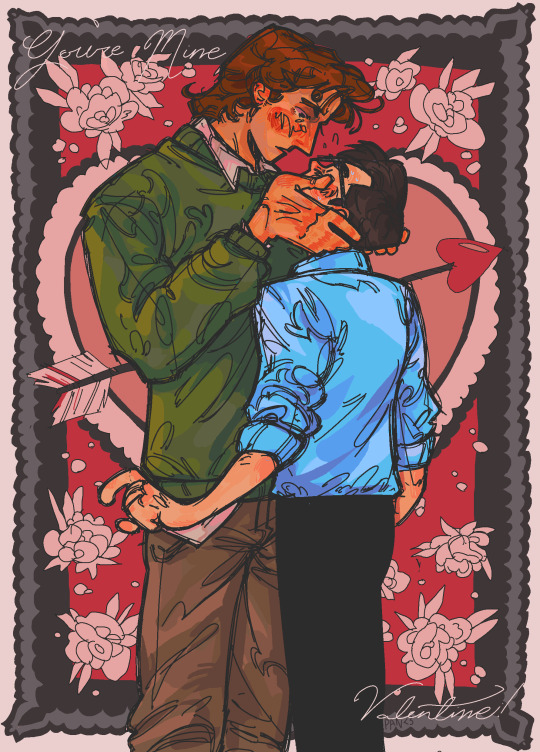
i think dan should get to be a little weird too. as a treat
#my art#re animator#herbert west#daniel cain#dan cain#danbert#no but srsly guys i get that hes the normal guy but you forget ... HES ALSO WEIRD !!! HES SO STRANGE !!!#if he was normal he would have called the cops on herbert ages ago#but guess what babey he ... well technically he did call the cops but he waited like 20 years to do it so .. !!#bro was an enabler dont forget that#sorry im like rlly crazy about dan...#which is unfortuante bc i feel kind of alone in that like YES herberts a baddie YES hes litterally me#but dan....... DAAAAAAAAAAAN (eagle screeching)#what the fuck am i saying!#edit hey guys its actually lucid dog that rant you see above you was written at likes 6am after an all nighter#we all know dan is weird i mainly meant i think he should get to be PORTRAYED as weird more#really im just weird about him (<3) and i need him to reflect that
2K notes
·
View notes
Text
mmm throwaway conversation between Dan and Danny that popped into my head that I had to write out:
"You spent ten years being a one-man mass extinction event, then went back in time and fought me, and lost." Danny snarls, arms crossed and throat tight. His mouth pulls back to bare dagger-sharp teeth, and his eyes burn with the familiar thrum of ectoplasm heating up behind his eyes. "If I didn't believe you were half of Vlad before, I do now."
His other self -- and really, can he even call him that? He's half of Vlad too. Two halves severed from each other and welded together to make a new whole, -- snaps his head over to him. Wild-eyed and furious, he looks unlike the man Danny fought before, the one unruffled and untouched, unbothered by the world around him. It's familiar, but not like the way a reflection is.
"What's that supposed to mean." The Other hisses, matching Danny's scowl one-for-one with fangs much bigger and sharper than his.
But there's a reason lions fear hyenas. Danny matches the rumble in The Other's chest with one of his own, and shoves his face close to his. "I don't lose."
#danny fenton#danny phantom#dp prompt#danny phantom prompt#dan phantom#dark danny#not meant for any particular au i just had the idea of danny going 'wow you can tell you're half of vlad' to dan and when questioned abt it#he says; 'if you were REALLY only me you wouldn't have lost' which is fucking BASED as hell. and also technically true#thought process for danny here was 'hates dan's fucking GUTS bc he tried to kill his family and friends without remorse and would actively#rip out his throat without a moment's notice.' some fr 'im going to beat you to death with my bare hands!' vibes rn.#not totally in character for danny but also i was thinking that it got to this point bc dan was goading danny about 'being his future self'#when that's not technically true. he's half of vlad too he just has danny's face and powers. and he pissed off danny enough that he#retaliated. just not in the way dan expected. dan was expecting a physical attack not a verbal one.#danny called him a loser in more ways than one.#also the reason danny never calls him 'dan' in this is because i was thinking that danny doesn't actually *have* a name to call him. bc he'#certainly not danny. but he's not vlad either. he's someone else entirely. so 'The Other' it is.#danny fenton is not the ghost king#<- down here because while its still MY DP post its not DPXDC so it doesnt need to be front and center for people to see it.
854 notes
·
View notes
Text




some doodles
#i meant to put the balor one in the previous post but i forgor 😭its in a diff file from the sketch dump i was coloring in so it just didnt#exist in my mind at all. i felt like smth was missing as i was posting it but i couldnt place what hlep#adeline and eiland have been driving me insane lately. expect more of them. probably.#dont minf the last two guys. some concepts for future farms 😋 (pls mind them im crazy abt all my farmers even if they technically dont -#exist yet. pls ask abt them or smth pls im nroaml i can be nroma l i prommy)#fields of mistria#fom balor#sona#im gonna start tagging that i think.#fom eiland#fom adeline#fom elsie#fom farmer#my art#guys can i just say that im so happy that balor is silver n not gold cus otherwise i would have to confront a part of me im not proud of#we shouldnt talk abt it but like yeah jjust know i like his silver and his whole deal#have such a softspot n bias for characters who dont settle anywhere. who never lay down their roots or whatever. who keep their past secret#like oughh hes hitting so many marks#i like hawthorne a lot. hes more developed in my head. and also i like his dead look and hair bows. i have so many ideas abt him man it hur#i promised myself i wouldnt make a new save file til i reached y2 w rory but apperantly errols bday is cursed bc the game has frozen twice#sorry if you read all of these tags. go to my askbox w fom stuff or smth. ask abt my farmers plsplspls pl s jk haha unless. maybe even#gimme drawing reqs for fom in general. ok tyvm ly sorry for yapping. its what i do best
153 notes
·
View notes
Text
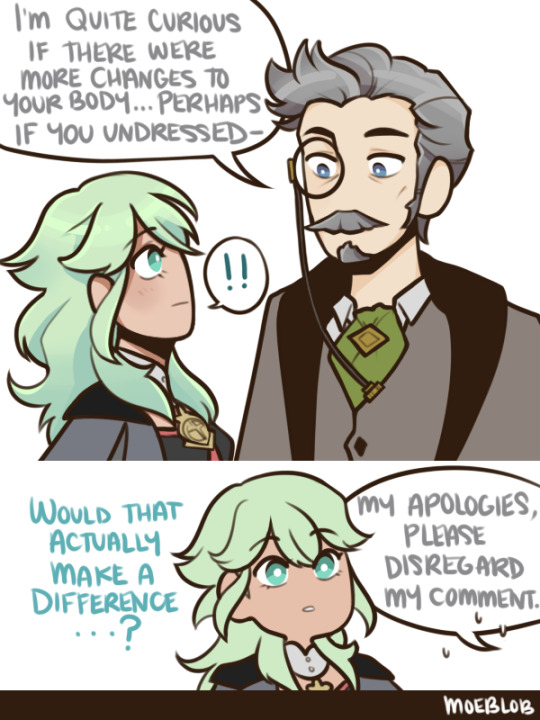
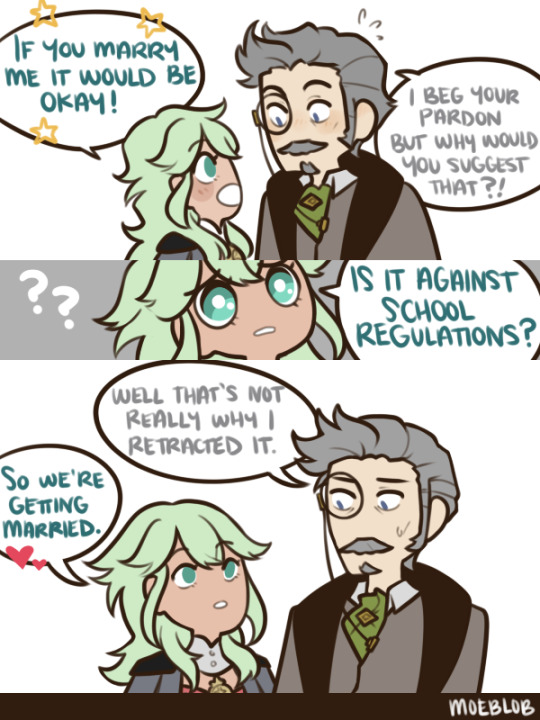
Sorry I forgot Hanneman suggested Byleth undress after they show up with a different hair color. And I miss Hanneman. And also while swapping between Houses and Hopes and seeing Hanneman pop up to help in a Hopes paralogue is just devastating since he doesn't ever actually join you at all and I am denied my old man rights.
So I had to draw this. Thank you for understanding.
#fe three houses#byleth#hanneman von essar#i like that Byleth just kinda stares at him and he realizes WHAT HE SAID and the implications and is like#step back uh forget that I said that#like man so zoned in on research he blurts that out and has to backtrack mentally to AH socially bad to say that my bad#if i need to tag this as anything lemme know even though it is a conversation in game basically (minus the marriage)#also if you have never married hanneman i genuinely enjoyed his s support and was VERY surprised and hes just#honestly one of my favorites overall in 3h ?? and im still bummed i cant play as him in thropes like thats just mean#also i think if byleth was like oh well if its awkward to see someone undress randomly#then marriage would solve the awkwardness this is truly the best deduction#which is really funny that i can see it happening with both leths despite my hc of them#with fyleth as bi and myleth as ace i think both would just be like AH cool we can avoid awkwardness by marriage#and hanneman just wants to go lie down in a ditch because he said something like that#and and byleth doesnt even know about religion while working at church school they dont know about school regulations#that wasnt really on their mind to check ok just saying you could tell byleth no to something#and then they just go oh school policies i understand unfortunately#and the person is like no we just meant its frowned upon to do archery practice in the tea garden its not technically illegal just dont??
188 notes
·
View notes
Text
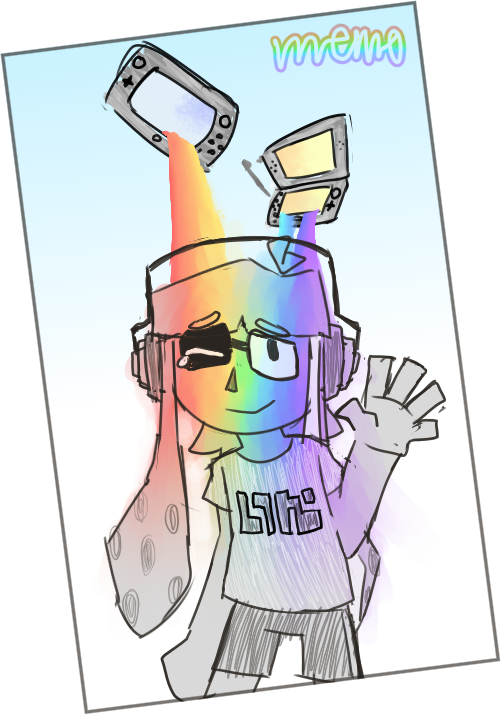
until next time.... stay fresh [plain text: until next time.... stay fresh]
#splatoon#splatoon 1#wii u#memo's constellations#inkling girl#memo's agents#memo agents: 3#technically. its the splatoon 1 promo inkling but based off of my 3 design#sad im probably not gonna get to play splatoon in its last moments#its okay though#god. the 3ds and wii u era was fucking awesome#im gonna miss her#triforce heroes‚ splat1‚ pushmo world... god. god#i listened to noteblock's 3ds settings remix and it actually made me cry because triforce heroes showed up in the background#and then it hit me how long its been and how much these two consoles have meant to me#the 3ds was really my gateway into art#thank you colors 3d. ive made it so far because of you#man. something about the online services ending the same day as the eclipse over here.#and the wii u was technically also my gateway into art with splatoon. it made me draw so much more#do you know how much splatoon ive drawn. that game changed me. that game makes me who i am today#thank you
130 notes
·
View notes
Text
Trying to understand Otto a little more, and this scene is a good exercise. We have a Viserys who is frustrated because Rhaenyra is being a broody teen and he doesn't get why... (maybe because you married her homoromantic best friend idk). He doesn't know how to manage the marriage proposals, which is traditionally the wife's duty, and obviously Otto jumps in to help him.




My first thought about the expression Otto makes was him thinking: “I couldn’t relate LESS” but to be serious for a minute, I think he’s probably thinking “Well, aren’t you in a position to decide what happiness looks like for Rhaenyra, in the long term?”
I do think Otto believes that about Alicent, that the choices he is making for her and the things he's commanding her to do will lead to her happiness. The ambitious mind of a Hightower, Lord Hand, obviously prioritizes having his blood in the royal line, for him that equals happiness. So her feelings and wants and ideas of happiness don't really matter, cause "father knows best". And I think this is actually a good representation of shitty parenting, thinking that your child can be molded into a specific ideal of what the future should look like, in a lot of cases even getting into heights you couldn't reach yourself, and thus fulfill your dreams. Yes, Otto we know you wanted to marry Viserys, get in line Daemon also wanted to.
No, but really, in the next moment, he says that Aegon should marry Rhaenyra and in that way reconcile his desires with Viserys', thinking of their children and grandchildren as no more than pieces on the board. Full circle moment when Alicent literally points out this to Otto in 1x09, beautiful.
Otto shows his love by carefully laying a path before Alicent, with what he believes to be happiness at the end. Is it love, though? For him, it is. We have to ask Alicent, though. That love probably feels like feeding a little bird in a cage , asking her to happily sing the tune of her heart, and complaining when the bird wallows in her misery.
#house of the dragon#hotd#alicent hightower#otto hightower#viserys targaryen#rhaenyra targaryen#otto and viserys co-parenting kinda#how to be a single father in westeros#viserys is technically a single father as well cause the way he treats alicent is almost like his daughter#bc of course a targaryen can never be normal about his family#also tbf otto treats alicent kinda like a wife so its not a targaryen thing#i think thes dynamics are meant to highlight the fact that alicent has not one normal relationship in her life#shes always expected to fill roles that have multiple levels of realization#eternally confused and pulled to different expectations#always wanting to please#so desperate to please#while at the same time craving the freedom she felt with rhaenyra#to just be herself#to just be loved for being herself#this wasnt a rhaenicent post but it kinda turned into one lmao#fork found in kitchen#oh and when i circle back to this post when i talk about alicent and her children#the apple dont fall far from the tree babe#otto failfather#alicent faildaughter failwife failmother LOVE OF MY LIFE
25 notes
·
View notes
Text

Back to assassins creed inspired fakemon, these where inspired by Desmond miles! Immolamb, (immolation and lamb) who is meant to look like a will o whisp,
Bansheep (banshee, sheep) who is inspired by the deer in spookys haunted mansion/ house of jumpscares and has 2 forms - wooled and sheared- that change stats and power up fire type or ghost type moves respectively,
and the third evo, who still doesn’t have a official name, but I’m thinking Fenwool (Fenrir, Wool, also fen is another word for a swamp or bog, where will o’ whisps were commonly found) and is inspired by the saying “wolf in sheeps clothing”
all 3 are fire/ghost types
also big thanks to @teecupangel for helping me flesh out this guy a little more,( he’s actually the first fakemon I’ve made) there’s more art in the ask I sent. I’ll try to link it later, maybe.
#desmond miles#fakemon#crossover#i have another fakemon inspired by Desmond#Because he’s my fav#And because immolamb is inspired by the ending of his story#The other unnamed fakemon is inspired by who he was before everything went to hell#Immolamb is so fun to draw#I have so many sketches pls help#Also despite its name it’s not technically a sheep#Honestly its more a canine with hooves and wool#Also also it’s 1st evo is meant to be a baby Pokémon#Like togepi or happiny
25 notes
·
View notes
Note
es should go through the blender but my finger is tired of holding down the button. so i shall pass the blender to you (with an es nui in it). do whatever you wish with them.
Oh why thank you :) I will take the blender gladly :) *Tosses some T2 angst into the blender* *adds a little bit of funky structure/style* *gives it a little pinch of headcanons* *and another pinch of random angst I got from ace attorney at 14 and never forgot* :) BBBBBBRRRRRRRRRRRRRRRRRRRRRRRRRRRRRRRRRRRRR
Caretaker Log J.16.7.2
Summary – The Warden’s condition continues to worsen since last entry. All decline remains self-inflicted.
J.16.7.2-M – Sleep deprivation has resulted in mood swings and irritability. Though denied by the Warden, extreme distress, melancholy, and laughter have been noted. They lash out verbally and physically toward the prisoners (1) only to apologize at a later time. Observations (2) result in speculation that hallucinations are another symptom.
J.16.7.2-B – The Warden's obsession with notetaking remains steady, though most pages of planning are merely rewritten versions of earlier notes. Their nightly ritual has grown more rigorous: four cups of coffee ingested in the time between dinner and the kitchen’s closing. A fifth cup is brought back to the courtroom, where the Warden will once again sleep on the ground. (Refer to J.5.5.2.B for initial detail.)
J.16.7.2-P – Sleep deprivation and/or caffeine intake has caused shakiness and overall weakness. They show severe eyebags and have not changed into nightclothes in several days. Though they wash themself and fresh civilian clothes have been provided, they insist on returning to the uniform. Motor skills (3) and computation abilities have suffered.
J.16.7.2-S – The Warden spends their days around the prisoners, but avoids participating in all necessary conversations and activities regardless of invitation (4). They limit speech to the Caretaker only about their denied request (5), though they can be coaxed into conversation when fatigue overtakes them.
(1) After 005 offered the Warden something to help with their sleep, they threw the pills to the ground and shouldered past with force; 008 attempted to read the Warden’s notes, and they slapped her hand away.
(2) Flinched away from 003 even when standing still; shocked expression at 004's face despite nothing out of the ordinary; looked nauseous and refused to eat fresh fruit from the dining hall; interrupted a conversation with 010 to listen to silence.
(3) Handwriting has grown nearly intelligible; dropped one of their coffee cups and nearly panicked at the subsequent breakage and spill.
(4) Left the room when 002 began setting up a game; ignored 001's encouragement to join him for a meal; refused to answer personal questions from 006; snapped at 007 when trying to begin a lighthearted conversation.
(5) Request submitted on 30.8.2 for padlocks to fit supply closet and cell doors.
Appendix. Subjective caretaker commentary – Poor kid. I’m glad it’ll all be over soon.
#milgram#es#(okay so i wanted to do something fantasy-esque like fugue route but i kept getting Plagued with this concept)#i love leaning into milgram as an experiment -- no matter how unethical and fucked up its still organized and the data meticulously reporte#it was weird to do something that stated much more than narrative writing but still felt like it was leaving a lot of blanks in the story#the aa angst is godots coffee obsession/his fear of falling back asleep -- after the disaster of es' t1 nap i think they would do#everything in their power to stay awake when they think its getting closer to trial closing time ;--; even if its killing them ;--;#if theyre not in their room jackalope cant give them the report#if theyre hyped up on caffeine their body cant be drugged to sleep#if they just take a few more notes on the prisoners... just do a little more planning of verdicts... everything will be okay...#if they just...#< reflecting the audience's obsession with controlling the prisoners/outcomes in es my beloved <3#what hurt most is that this trial end came late compared to t1 -- the reference to the other entry is meant to show they were#preparing for the trial end since 5/5 when it should have been if the numbers worked out the same#thus theyve been destroying their body ever since then - it would have been 70+ days in between and im SAD#i know nothing about how social experiments/psychology info is documented but as someone doing specifically organized technical writing it#was super fun to come up with a little fantasy system for experiment documents :3#the letters are meant to stand for mental/behavioral/physical/social -- those seemed like pretty standard categories for a case study?#oh and the padlock request was made the day of amanes interrogation 😅#also peppering in a headcanon from mug im still crazy over about es seeing glimpses of the mvs as hallucinations when theyre too tired#one of these days ill finally write fantasy milgram... we'll see...#thank you so much for the request!!!#the holidays delayed it a bit but it was super fun to work on :3#blend them........#drabbles
11 notes
·
View notes
Photo
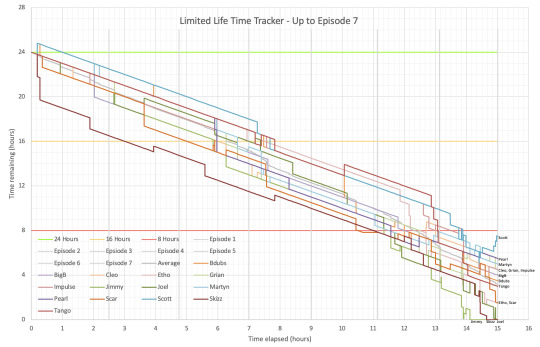
Life Tracker updated for Episode 7! This one is much quicker than Episode 6 on account of not being on holiday at the time, even though there were two thirds more deaths this time. Previous posts: Session 6, Session 5, Session 4. Also Session 8 (finale) post!
As usual, close ups and commentary below the cut. I’ve also added another graph for the average time of each team, which will also be below the cut.
There was so much carnage! 45 whole deaths in a single session! Not all deaths were awarded time during the session, but Scott’s video advised that it would be added by next session, so I have taken the liberty to add all the time as I see fit, hence why Scott is back to 7.5 hours. I haven’t seen every episode yet (in fact, other than Scott, I’ve only seen those that have perma-died), so I’m not sure if anyone else’s time is a mismatch, but if so I’m happy to explain where I’m getting my time additions and subtractions from!
Now for some close ups.
First, there was enough chaos that I decided to take a close up of Session 6 and 7 together so we can properly appreciate it:

And a close up of Session 7 by itself:
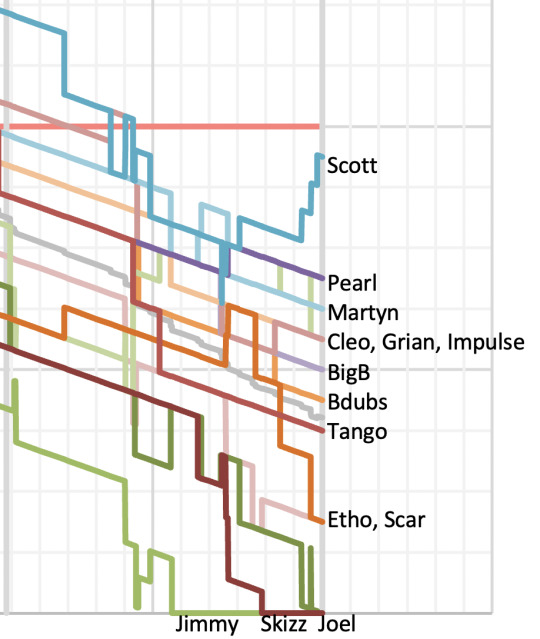
So many people lost major time, so it’s interesting to see Scott’s uptick of time at the end - he ended on only 30 minutes less than he would have been if he hadn’t died at all this session. Pearl didn’t die at all, and got the kill credit for Martyn blowing himself up in a trap, so she actually ended the session 30 minutes better than she started it. Grian also did very well for himself - he killed and died so many times, but somehow ended on the exact time he would have been on if he had experienced a peaceful deathless session.
BigB, Cleo, and Martyn all ended the session 1 hour poorer than they started, and Bdubs and Scar ended 1.5 hours below where they would have been. Nosy Neighbours are thus doing super well, with Mean Gills and Clockers not too far behind, in terms of maintaining position from the start of the session.
TIES had an awful time this session, with Impulse and Tango both losing a net 2 hours, and Etho and Skizz losing a net 2.5 hours - and obviously Skizz entirely died.
Joel possibly had the worst time, losing a net 3.5 hours this session - though it didn’t help that 5 of his 7 deaths were all caused by the one person. Technically Jimmy didn’t do too badly, given he only lost a net 1.5 hours... but given that he was out of the series only an hour into the session, and also the first out entirely... it really didn’t go well for him either
I also find it interesting the sheer number of vertical lines this graph, the ones representing a death immediately followed by a kill or vice versa. I would love to figure out a way to show only one line at a time on the graph, so we can more easily see someone’s journey, but I haven’t had time to look into it yet.
Now onto the graph of the average times per team.
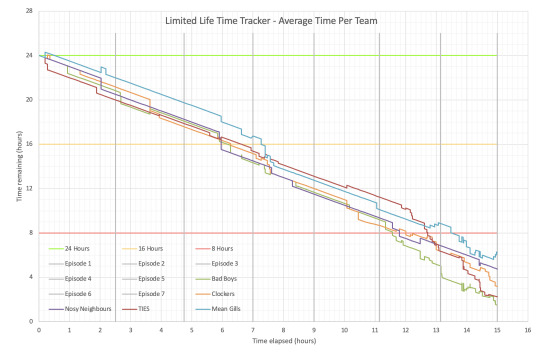
This one is super interesting to me, especially TIES’s line - they had the lowest average life right from the start, but somehow by Session 4, through Session 5, and for most of Session 6, they were the team with the highest average time, and then it quite literally went downhill from there. The only thing saving them from being last now is the fact that the Bad Boys are down to only a single living player, and even then Grian is doing far better than most of TIES.
It’s also interesting to me how Mean Gills had a significant time uptick at the end of both Session 6 and Session 7 (the first due to Martyn and the second due to Scott). Scott’s time was so high that it kept Mean Gills’ average time as yellow for all of Session 6 despite Martyn being red for most of it... and Martyn then got enough kills to keep it there. Mean Gills is also the only team in the entire graph to anywhere gain such consistent significant time.
These averages also coincide with the comments I made above about the time offset difference for each player from the start to end of the session. Mean Gills are doing well, but they’ve been doing well for so long that I’m sure most players are aware that they need to be a target. Nosy Neighbours are also doing well but I feel like they’ve flown under the radar, and are not a significant target right now.
Here is a close up of this graph with Sessions 1-4:

And the close up for Session 5-7:

And the Session 7 only close up:

I kept the dead players in the teams’ averages, since I think it is a better reflection of the teams’ strength as a whole, but I also created a version that excluded dead players. In those screenshots you can really see Bad Boys’ and TIES’ time jumping up at a death, instead of falling as it did here.
Here are the alternate averages graph:

And close ups:
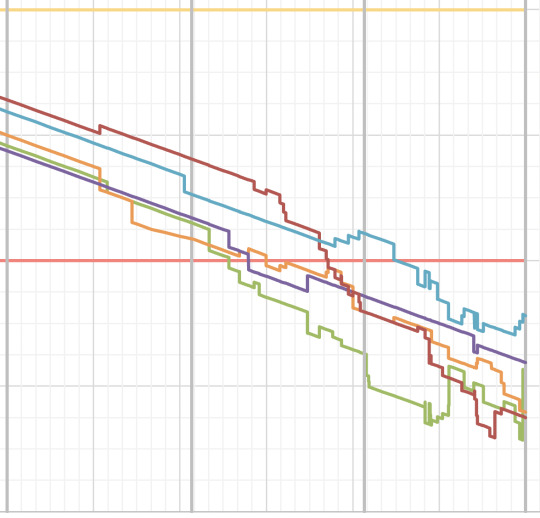
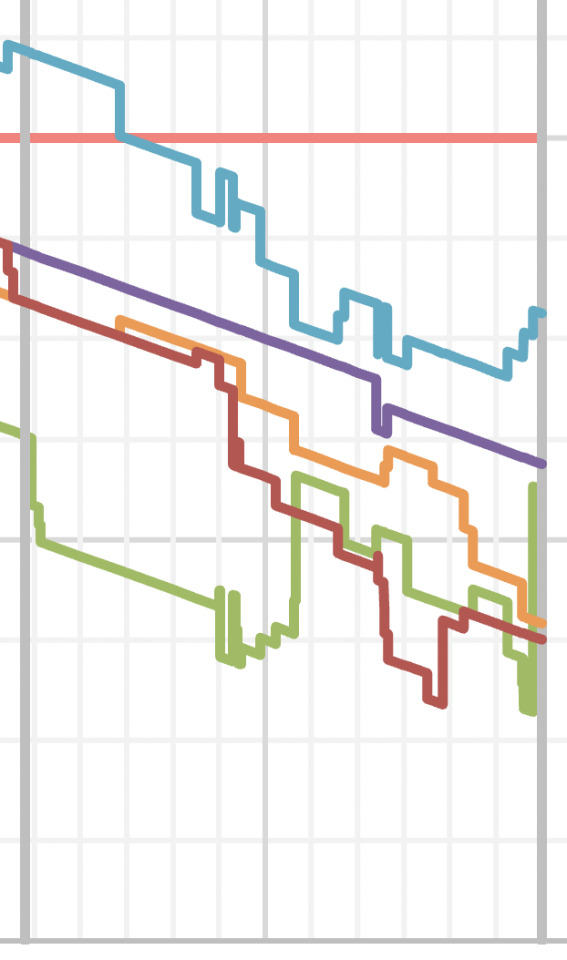
This makes Bad Boys look a lot better, because Grian does have a lot of time... but he is also alone. And there is definitely strength in numbers. Two players at an hour and a half each can fend off an attacker more easily than a single player at three hours can... unless nerves and panic get to them, as we definitely saw this session.
Wow and I almost forgot to include the raw data for this session!
The first hour of the session:

The second hour of the session:

There is just so much death! Look at all the box outlines!! I could barely fit this data on two screens on the zoom I was on, and I did not want to zoom out further.
I also obviously have data for the averages, but it was too far away from the column with the times on it that I wasn’t sure if it would still be useful on its own? Let me know if you want to see it!
This has once again been fascinating to see, and I cannot wait to see how Session 8 will go. Will it be the last session? Will they go until everyone is dead? Will they somehow have enough people with enough time to get to Session 9? Will Mean Gills be the final two and get to play fun relaxing games like Scott was suggesting?
Only time will tell.
#limited life smp#24lsmp#limlife#once again i hate trying to work out what tags for a post#i got to this point in the tags before i realised i forgot to add the number data#i still love that impulse accidentally killed scott and became yellow again#and that scott also became yellow again#so there was less than 14 minutes between there still being two yellows on the server... and jimmy permadying#thirteen minutes and 41 seconds exactly by my calculations#which is crazy given we had whole sessions of yellows only#which meant it was hours between last green and first red#so less than a quarter of an hour between last yellows (and two of them!) and first permadeath is crazy#i always ramble in the tags bc i dont know how to wrap the post up#why do i always post these as im going to bed#its after midnight and im yawning now#anyway enjoy!#very glad i got to post this before the weekend ended this time#well it was still sunday when i started writing the post#its 12:15am on monday now. technically#my spreadsheets
280 notes
·
View notes
Text

Dragonfang cannot speak in words, she just injects feelings and emotions directly into Adam's spine to communicate (This also means he's the only one who can "hear" her)
I thought of a way to represent that in comics is to have her speak with emojis :]
#windyart#adam#dragonfang#scribble comic#i mean technically...#i have a couple other scribbles i did alongside this one yesterday but they are not relevant and i wanted to explain this lore too#so i will post those separately... eventually. maybe#the hollowridge disaster#also sidenote but i cannot express how much more natural drawing adam this way feels. even thinking about him is so much easier#its like this was hardcore meant to be. and its also a lot more fun too#i love him so much
361 notes
·
View notes
Text
side note, i really like how we've had several scenes now of Kurapika praying to his people and their gods/ancestors. i feel like these little cultural rituals, beyond clothing or his eyes, is what really connects Kurapika to his core past and character to me. He prays before he takes his first kill, and he prays after he buries him. He confronts his anger of his peoples' murder, his grief at their lives taken and the life he has taken, and his fear of what he know he must/will/is become/becoming, and the ritual of spoken prayer soothes that swirling agony into a redemption of purpose:
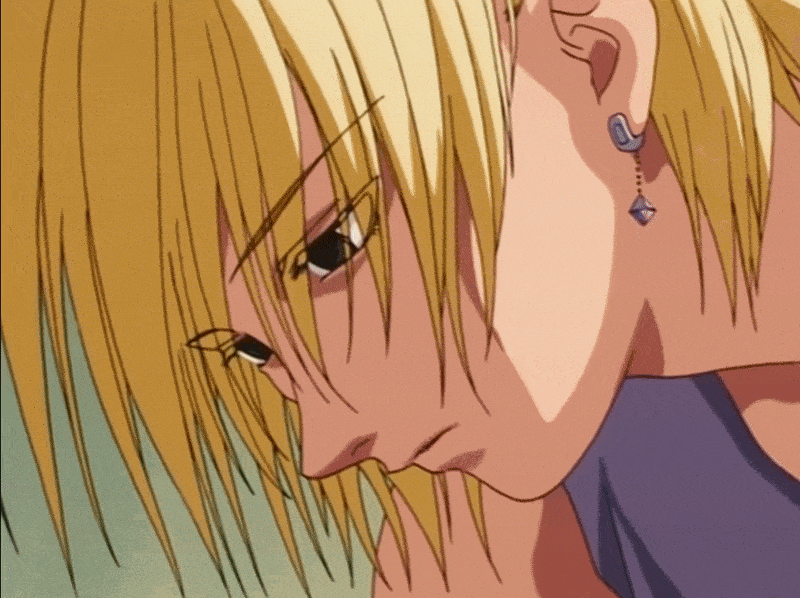
"The sun upon my face, the grass beneath my feet.
My skin cleansed by the water of a lake.
My spirit soars among the clouds,
my path illuminated by the moon and stars.
I honor my ancestors for bringing me to this place,
and defend my brethen with my dying breath.
I will step forward to humbly share in their joy
and carry the burden of their sorrows.
By my word and deed, their name will live on...
For my scarlet eyes and my blood are one with theirs,
I will take up the mantle, and accept any wrongdoing I commit,
to preserve the Kurta people, until we are redeemed forever.
On the scarlet eyes, I swear this."
(-Episode 58)
#i just really love the care and attention to the characters that 1999 is afforded#that we get kurapikas prayer in text is very important to me#i recently had two family members die in quick succession of each other and im very sensitive to mourning rituals atm sadbjhvdbhsa#kurapika is a mess of self regulatory rituals meant to be preformed within a community#not having a community really fucks with him. hes MEANT to.#episode number added since its a direct quote#.....god i cant believe the first literary analysis i do since graduating is through hxh 1999 posting on tumblr#so fucking funny to me. happy 2025#wait technically this is my first post of 2025 LMFAOHSDJGJHSABVDGFSAJVHB#HAHAHAHHAh#depths' watches#hxh#hxh 1999#also this gif gave me more trouble than any other#i had to work to get it to fit the file size of tumblr#which feels like bullshit bc i swear ive uploaded things over 20MB?!?!??!
15 notes
·
View notes
Text
There's a certain something something to Bojack Horseman that makes it not really furry media despite ostensibly having all the elements it needs. I think I need to rewatch that Patricia Taxxon video bc for the life of me I cannot figure out what it is
#is it the art style? the content?#i feel like furry stuff today and furry stuff of the 90s i occasionally see and like disney robin hood is all on a continuum#like theres a timeline there#but bojack horseman is like. outside of that#but how???#it literally cant be#i just dont see it and think furry#i do remember the video mentioning sensory elements of furry content which#in all honesty#bojack horsman does Not do im my memory#like dog characters act like dogs but theyre not fluffy even if they technically are#funny how they confirmed horse characters have horse dicks tho. thats histerical love it 10/10 no notes#the art style is probably part of it a bit tho because every animal is just animal head + fur or feathers or whatever + normal human torso#regardless of anything#with no tail#except one scorpion#so its stylized but its not flexible like most furry stuff is#i dont wanna say it doesnt allude towards the autistic though because i really have no idea#might send her an ask#theres also the fact that the characters arent fursonas unless they reference someone specific and then they rarely are mesnt ro mean shiblt#beyond puns#like mr. pb isnt someone as a dog. hes a dog#but maybe all furry stuff is like that#i think the animal stuff in BH is meant to be entertaining and connect the audience to a certain reality where accidently winning a ski race#to become governor of california is possible in the same universe as serious decades long history of alcoholism#having the MC be a horse opens the door for him to drink comical levels of alcohol and be a former sitcom character in-universe#which is a) funny as fuck and b) makes it easier to stay invested as the show slowly but steadily tells you in season 1 early on that ->#things do matter in this show and the things you find funny are also frequently very real and we will tell tou what the difference is if#you listen. so theres that#hit tag limit gdnt
6 notes
·
View notes